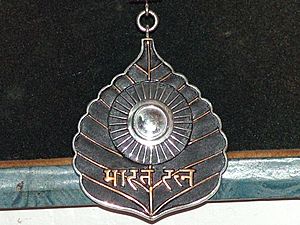Bharat Ratna facts for kids
Quick facts for kids Bharat Ratna |
|
|---|---|
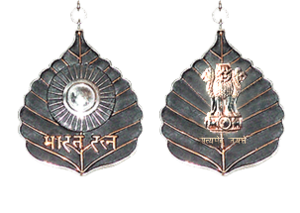 |
|
| Awarded for | Highest Civilian Award of the Republic of India |
| Presented by | |
| Country | |
The Bharat Ratna (Hindustani pronunciation: [bʰaːɾət̪ rət̪nə]; Jewel of India) is the highest civilian award of the Republic of India. Instituted on 2 January 1954, the award is conferred in recognition of "exceptional service/performance of the highest order", without distinction of race, occupation, position or gender. The award was originally limited to achievements in the arts, literature, science, and public services, but the Government of India expanded the criteria to include "any field of human endeavor" in December 2011. The recommendations for the award are made by the Prime Minister to the President. The recipients receive a Sanad (certificate) signed by the President and a peepal leaf-shaped medallion with no monetary grant associated with the award. Bharat Ratna recipients rank seventh in the Indian order of precedence.
The first recipients of the Bharat Ratna were: the former Governor-General of the Union of India C. Rajagopalachari, the former President of the Republic of India Sarvepalli Radhakrishnan; and the Indian physicist C. V. Raman, who were honoured in 1954. Since then, the award has been bestowed upon 53 individuals, including 18 who were awarded posthumously. The original statutes did not provide for posthumous awards but were amended in January 1966 to permit them to honor former Prime Minister Lal Bahadur Shastri, the first individual to be honored posthumously. In 2014, cricketer Sachin Tendulkar, then aged 40, became the youngest recipient, while social reformer Dhondo Keshav Karve was the oldest recipient when he was awarded on his 100th birthday. Though usually conferred on India-born citizens, the award has been conferred on one naturalized citizen, Mother Teresa, and on two non-Indians: Abdul Ghaffar Khan (born in British India and later a citizen of Pakistan) and Nelson Mandela, a citizen of South Africa.
The Bharat Ratna, along with other personal civil honours, was briefly suspended from July 1977 to January 1980, during the change in the national government; and for a second time from August 1992 to December 1995, when several public-interest litigations challenged the constitutional validity of the awards. In 1992, the government's decision to confer the award posthumously on Subhas Chandra Bose was opposed by those who had refused to accept the fact of his death, including some members of his extended family. Following a 1997 Supreme Court decision, the press communique announcing Bose's award was cancelled; it is the only time when the award was announced but not conferred.
Contents
History
On 2 January 1954, a press communique was released from the office of the secretary to the President announcing the creation of two civilian awards—Bharat Ratna (Jewel of India), the highest civilian award, and the three-tier Padma Vibhushan, classified into "Pehla Warg" (Class I), "Dusra Warg" (Class II), and "Tisra Warg" (Class III), which rank below the Bharat Ratna. On 15 January 1955, the Padma Vibhushan was reclassified into three different awards; the Padma Vibhushan, the highest of the three, followed by the Padma Bhushan and the Padma Shri.
The award was briefly suspended twice in its history. The first suspension occurred when Morarji Desai, who was sworn in as the fourth Prime Minister in 1977, withdrew all personal civil honours on 13 July 1977. The suspension was rescinded on 25 January 1980, after Indira Gandhi became the Prime Minister. The award was suspended again in mid-1992, when two Public-Interest Litigations were filed, one in the Kerala High Court and another in the Madhya Pradesh High Court, challenging the "constitutional validity" of the awards. The awards were reintroduced by the Supreme Court in December 1995, following the conclusion of the litigation.
There is no formal provision that recipients of the Bharat Ratna should be Indian citizens. It has been awarded to a naturalised Indian citizen, Mother Teresa in 1980, and to two non-Indians, Abdul Ghaffar Khan of Pakistan in 1987 and the former South African president Nelson Mandela in 1990. Sachin Tendulkar, at the age of 40, became the youngest person and first sportsperson to receive the honour. Dhondo Keshav Karve was the oldest living recipient when he was awarded on his 100th birthday on 18 April 1958. As of 2024[update], the award has been conferred upon 50 people with 15 posthumous declarations.
Regulations
The Bharat Ratna is conferred "in recognition of exceptional service/performance of the highest order", without distinction of race, occupation, position, or gender. The award was originally confined to the arts, literature, science, and public services, as per the 1954 regulations. In December 2011, the rules were amended to "any field of human endeavour". The 1954 statutes did not allow posthumous awards, but this was subsequently modified in the January 1966 statute, and Lal Bahadur Shastri became the first recipient to be honored posthumously in 1966.
Although there is no formal nomination process, recommendations for the award can only be made by the Prime Minister to the President. The recipient receives a Sanad (certificate) signed by the President and a medallion without any monetary grant. Usage of the title 'Bharat Ratna' as a prefix by the awardee is exempt from Article 18 (1) of the Constitution, as per the Supreme Court's precedent in Balaji Raghavan/S.P. Anand v. Union of India in 1995. Additionally, recipients may either use the expression "Awarded Bharat Ratna by the President" or "Recipient of Bharat Ratna Award" to indicate that they have been honored with the award. The holders of the Bharat Ratna rank seventh in the Indian order of precedence.
As with many official announcements, recipients are announced and registered in The Gazette of India, a publication released by the Department of Publication, Ministry of Urban Development used for official government notices; without publication in the Gazette, conferral of the award is not considered official. Recipients whose awards have been revoked or restored, both of which require the authority of the President, are registered in the Gazette. Recipients whose awards have been revoked are required to surrender their medals, and their names are struck from the register.
Specifications
The original 1954 specifications of the award was a circle made of gold 1+3⁄8 inches (35 mm) in diameter with a centered image of the sun on the obverse side. The text "Bharat Ratna", in Devanagari Script, is inscribed on the upper edge in silver gilt with a wreath set along on the lower edge. A platinum State Emblem of India was placed in the center of the reverse side with the national motto, "Satyameva Jayate" in Devanagari Script (Sanskrit: सत्यमेव जयते; lit. "Truth alone triumphs"), inscribed in silver-gilt on the lower edge.
A year later, the design was modified. The current medal is in the shape of a peepal leaf, approximately 2+5⁄16 inches (59 mm) long, 1+7⁄8 inches (48 mm) wide and 1⁄8 inch (3.2 mm) thick and rimmed in platinum. The embossed sun burst design, made of platinum, on the obverse side of the medal has a diameter of 5⁄8 inch (16 mm) with rays spreading out from 5⁄6 inch (21 mm) to 1⁄2 inch (13 mm) from the center of the Sun. The words "Bharat Ratna" on the obverse side remained the same as the 1954 design as did the emblem of India and "Satyameva Jayate" on the reverse side. A 2-inch-wide (51 mm) white ribbon is attached to the medal so it can be worn around the neck. In 1957, the silver-gilt decoration was changed to burnished bronze. The medals are minted at Alipore Mint in Kolkata.
Entitlements
Bharat Ratna can not be used as a prefix or suffix, however recipients may identify themselves as "Awarded Bharat Ratna by the President" or "Recipient of Bharat Ratna Award". The award does not carry any monetary benefits, but the award includes the following entitlements:
- The medallion and miniature
- A Sanad (certificate) signed by the President of India
- Treatment as a state guest by state governments when traveling within a state
- Indian missions abroad requested to facilitate recipients when requested
- Entitlement to a diplomatic passport
- Placed seventh in the Indian order of precedence
- Concessional fare on the flag carrier Air India
Popular demands
Though, as per the statutes for the Bharat Ratna, the recommendations for the award can only be made by the Prime Minister to the President, there have been several demands from various political parties publicly to honor their leaders. In January 2008, Bharatiya Janata Party (BJP) leader L. K. Advani wrote to then Prime Minister Manmohan Singh recommending Singh's predecessor Atal Bihari Vajpayee for the award. This was immediately followed by the Communist Party of India (Marxist) lobbying for their leader, Jyoti Basu, former Chief Minister of West Bengal though Basu himself said that he would decline the honour, even if awarded. Similar demands were made by Telugu Desam Party, Bahujan Samaj Party, and Shiromani Akali Dal for their respective leaders N. T. Rama Rao, Kanshi Ram, and Parkash Singh Badal. In September 2015, regional political party Shiv Sena demanded the award for the independence activist Vinayak Damodar Savarkar stating that he had been "deliberately neglected by previous governments" but his family clarified that they are not making such demand and that the freedom fighter is known for his contribution towards independence movement and did not need an award for recognition.
Per the original statutes, sports-persons were not eligible for the award; however, a revision of the rules in December 2011 made eligible "any field of human endeavour". Subsequently, several sports-persons' names were discussed; amongst them were field-hockey player Dhyan Chand and former world chess champion Viswanathan Anand. In 2011, 82 members of parliament recommended Chand's name for the award to the Prime Minister's Office. In January 2012, the Ministry of Youth Affairs and Sports forwarded his name again, this time along with 2008 Summer Olympics gold medallist shooter Abhinav Bindra and mountaineer Tenzing Norgay while Bindra had already been recommended for the award in May 2013 by the National Rifle Association of India. In July 2013, the ministry again recommended Dhyan Chand. However, in November 2013, cricketer Sachin Tendulkar became the first sports-person to receive the honour and this garnered much criticism for the government.
In 2012, a litigation was filed in the Karnataka High Court requesting the court to issue a direction to the Ministry of Home Affairs to confer the Bharat Ratna upon Mahatma Gandhi. On 27 January 2014, a counsel appearing for the petitioner noted that after multiple representations from the petitioner, they were provided with the information under RTI that the recommendations to confer the award on Gandhi have been received multiple times in the past and were forwarded to the Prime Minister's Office. A Division bench consisting of the Chief Justice and another judge, dismissed the petition stating that the subject is not amenable to any adjudication process and the nominations and conferment process is stated to be informal and in the discretion of the highest authority in the Government.
List of recipients
| + Naturalised citizen recipient | * Non-citizen recipient | # Posthumous recipient |
| Year | Image | Recipient | State / Country | Life span | Notes |
|---|---|---|---|---|---|
| 1954 | 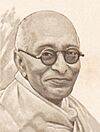 |
C. Rajagopalachari | Tamil Nadu | 1878–1972 | Rajagopalachari was an independence activist, who served as the last Governor-General of India from 1948 to 50). Earlier, he served as the first governor of West Bengal in 1947–48. He was the home minister in the first Nehru cabinet succeeding Sardar Vallabhai Patel in 1950. He served as the chief minister of Madras Presidency from 1937–39 and later as the chief minister of Tamil Nadu between 1952 and 1954. He founded the Swatantra Party in 1959. |
 |
Sarvepalli Radhakrishnan | Tamil Nadu | 1888-1975 | Radhakrishnan served as the first Vice-President of India from 1952 to 1962 and as the second President of India from 1962 to 1967). Since 1962, his birthday of 5 September is observed annually as Teachers' Day in India. | |
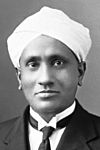 |
C. V. Raman | Tamil Nadu | 1888-1970 | Raman was a physicist known for his work in the field of light scattering. He is known for the discovery of Raman scattering and Raman spectroscopy and was presented the Nobel Prize in Physics in 1930. | |
| 1955 |  |
Bhagwan Das | Uttar Pradesh | 1869-1958 | Bhagwan Das was an independence activist, theosophist and educationist. He co-founded Kashi Vidyapith and worked with Madan Mohan Malaviya to establish the Banaras Hindu University. |
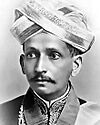 |
M. Visvesvaraya | Karnataka | 1861-1962 | Visvesvaraya was a civil engineer and statesman. He served as the 19th Diwan of Mysore from 1912 to 1918. His birthday, 15 September, is observed annually as Engineer's Day in India. | |
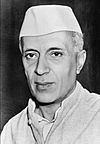 |
Jawaharlal Nehru | Uttar Pradesh | 1889-1964 | Nehru was an independence activist and politician, who was the first and the longest-serving Prime Minister of India from 1947 to 1964. | |
| 1957 |  |
Govind Ballabh Pant | Uttar Pradesh | 1887-1961 | Pant was an independence activist and politician, who served as the premier of United Provinces (1937–39, 1946–50) and as the first chief minister of Uttar Pradesh from 1950 to 1954. He served as Union Home Minister from 1955 to 1961. |
| 1958 | 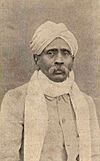 |
Dhondo Keshav Karve | Maharashtra | 1858-1962 | Karve was a social reformer and educator, known for his work on education for women and remarriage of Hindu widows. He established the Widow Marriage Association (1883), Hindu Widows Home (1896), and started Shreemati Nathibai Damodar Thackersey Women's University in 1916. |
| 1961 |  |
Bidhan Chandra Roy | West Bengal | 1882-1962 | Roy was a physician, politician and educationist. He served as the second Chief Minister of West Bengal from 1948 to 1962 and is known as the "Maker of Modern West Bengal". His birthday on 1 July is observed annually as the National Doctors' Day in India. |
 |
Purushottam Das Tandon | Uttar Pradesh | 1882-1962 | Tandon was an independence activist and politician, who served as the speaker of the Uttar Pradesh Legislative Assembly from 1937 to 1950. He was actively involved in a campaign to get official language status to Hindi. | |
| 1962 |  |
Rajendra Prasad | Bihar | 1884-1963 | Prasad was an independence activist, lawyer and statesman, who was associated with Mahatma Gandhi in the Champaran Satyagraha in Bihar and non-cooperation movement. Became the president of Constituent Assembly of India .He was later elected as the first President of India (1950–62). |
| 1963 |  |
Zakir Husain | Telangana | 1897-1969 | Husain was an independence activist and philosopher, who served as the Vice Chancellor of Aligarh Muslim University (1948–56) and the Governor of Bihar (1957–62). Later, he was elected as second vice-president of India (1962–67) and went on to become the third President of India (1967–69). |
 |
Pandurang Vaman Kane | Maharashtra | 1880-1972 | Kane was an indologist and Sanskrit scholar, known for his five volume literary work, History of Dharmaśāstra: Ancient and Medieval Religious and Civil Law in India. | |
| 1966 | 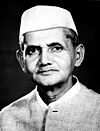 |
Lal Bahadur Shastri# | Uttar Pradesh | 1904-1966 | Shastri was an independence activist, known for his slogan "Jai Jawan Jai Kisan" ("Hail to the Soldier, hail to the Farmer"). He served as second Prime Minister of India (1964–66) and led the country during the Indo-Pakistani War of 1965. |
| 1971 | 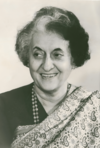 |
Indira Gandhi | Uttar Pradesh | 1917-1984 | Indira Gandhi was the Prime Minister of India during 1966–77 and 1980–84. She is known as the "Iron Lady of India", as she led India during the Indo-Pakistani War of 1971 and the concurrent Bangladesh Liberation War which led to the formation of Bangladesh. |
| 1975 |  |
V. V. Giri | Odisha | 1894-1980 | Giri was an independence activist, who organized trade unions and facilitated their participation in the fight for independence. Post-independence, Giri held positions of Governor of Uttar Pradesh, Kerala and Mysore state and other cabinet ministries. He became the first acting president and was eventually elected as the fourth President of India, serving from 1969 to 1974. |
| 1976 |  |
K. Kamaraj# | Tamil Nadu | 1903-1975 | Kamaraj was an independence activist, freedom fighter and a politician, who served as the Chief Minister of Tamil Nadu for over nine years, between 1954 and 1963. He was known as the "King Maker", as he was the president of the Indian National Congress, when electing Lal Bahadur Shastri the prime minister after Nehru's death and Indira Gandhi after Shastri's death. He later founded the Indian political party, the Indian National Congress (Organisation). |
| 1980 | 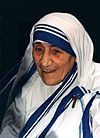 |
Mother Teresa + | West Bengal (b.Skopje, North Macedonia) |
1910-1997 | Mother Teresa was a Catholic nun and founder of the Missionaries of Charity, a religious congregation, which manages homes for diseased people. She was the recipient of the Nobel Peace Prize for her humanitarian work in 1979. She was beatified on 19 October 2003 by Pope John Paul II and canonised on 4 September 2016 by Pope Francis. |
| 1983 | 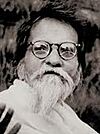 |
Vinoba Bhave# | Maharashtra | 1895-1982 | Bhave was an independence activist, social reformer and an associate of Mahatma Gandhi, known for his Bhoodan movement. He was known by the honorific title "Acharya" ("teacher") and was awarded the Ramon Magsaysay Award (1958) for his humanitarian work. |
| 1987 | 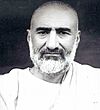 |
Abdul Ghaffar Khan* | Pakistan | 1890-1988 | Khan was a independence activist, a follower of Mahatma Gandhi and an advocate of Hindu–Muslim unity in the subcontinent. He was known as "Frontier Gandhi" and was part of the Khilafat Movement in 1920 and founded the Khudai Khidmatgar ("Red Shirt movement") in 1929. |
| 1988 |  |
M. G. Ramachandran# | Tamil Nadu | 1917-1987 | Ramachandran was an actor and politician, who was the founder of the Indian political party, All India Anna Dravida Munnetra Kazhagam and served as the chief minister of Tamil Nadu for over ten years, between 1977 and 1987. He is known by the sobrequet the "Puratchi Thalaivar" ("Revolutionary Leader"). |
| 1990 | 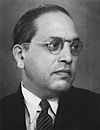 |
B. R. Ambedkar# | Maharashtra | 1891-1956 | Ambedkar was a social reformer, lawyer and a Dalit leader, who headed the committee drafting the Indian Constitution while also serving as the first Law Minister of India later. Ambedkar campaigned against the social discrimination of Dalits and the caste system in India. He was associated with the Dalit Buddhist movement after converting to Buddhism on 14 October 1956. |
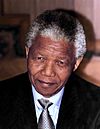 |
Nelson Mandela* | South Africa | 1918-2013 | Mandela was the leader of the Anti-Apartheid Movement in South Africa and later served as the President of South Africa (1994–99). Often called as the "Gandhi of South Africa", Mandela's African National Congress movement was influenced by Gandhian philosophy. In 1993, he was awarded the Nobel Peace Prize. | |
| 1991 |  |
Rajiv Gandhi# | Uttar Pradesh | 1944-1991 | Rajiv Gandhi was a pilot turned politician, who served as the sixth Prime Minister of India serving from 1984 to 1989. |
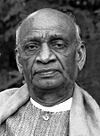 |
Vallabhbhai Patel# | Gujarat | 1875-1950 | Patel was an independence activist, who served as the first Deputy Prime Minister of India (1947–50) and home minister. Patel was known as the "Iron Man of India" and by the title of "Sardar" ("Leader") Patel and was instrumental in the accession of the princely states into the Indian union. | |
 |
Morarji Desai | Gujarat | 1896-1995 | Desai was an independence activist and politician, who served as the fourth Prime Minister of India from 1977 to 1979 and was the first to be not from the Indian National Congress. He was also awarded the Nishan-e-Pakistan, the second highest civilian award given by the Government of Pakistan. Desai had earlier abolished the awards while he was in the office of Prime Minister for it being "worthless and politicised". | |
| 1992 | 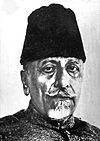 |
Abul Kalam Azad# | West Bengal | 1888-1958 | Azad was an independence activist and politician, who served as the first education minister of India. His birthday on 11 November is observed annually as the National Education Day in India. |
 |
J. R. D. Tata | Maharashtra | 1904-1993 | Tata was an industrialist, philanthropist, and aviation pioneer, who served as the chairman of the business conglomerate Tata Group. He is the founder of various educational and research institutes and businesses. | |
 |
Satyajit Ray | West Bengal | 1922-1992 | Ray was a film director. He directed his first film Pather Panchali in 1955 and is credited with bringing world recognition to Indian cinema. In 1984, Ray was awarded the Dadasaheb Phalke Award, India's highest award in cinema and in 1991, he received Academy Honorary Award. | |
| 1997 | 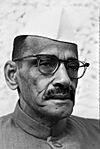 |
Gulzarilal Nanda | Punjab | 1898-1998 | Nanda was an independence activist and politician, who served as the interim Prime Minister of India in 1964 and 1966 and as the deputy chairman of the Planning Commission. |
 |
Aruna Asaf Ali# | West Bengal | 1909-1996 | Ali was an independence activist, known for hoisting the tricolor flag of India in Bombay during the Quit India Movement in 1942. Post Independence, she was elected as Delhi's first mayor in 1958. | |
 |
A. P. J. Abdul Kalam | Tamil Nadu | 1931-2015 | Kalam was an aerospace and defence scientist, who later served as the eleventh President of India from 2002 until 2007. He was involved in the development of India's first satellite launch vehicle SLV III and the Integrated Guided Missile Development Program, while working for various space and defence research agencies and has served as the scientific advisor to the defence minister, Secretary for defence research and director of Defence Research and Development Organisation. | |
| 1998 | 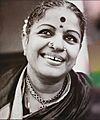 |
M. S. Subbulakshmi | Tamil Nadu | 1916-2005 | Subbulakshmi was a Carnatic classical vocalist, known for her songs, religious chantings and compositions. She was the first Indian musician to receive the Ramon Magsaysay award for her public service. |
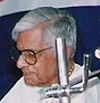 |
C. Subramaniam | Tamil Nadu | 1910-2000 | Subramaniam was an independence activist and politician, who served as the minister of agriculture from 1964 to 1966 and later as minister of finance and defence. He is known for his contribution towards the Green Revolution in India. | |
| 1999 |  |
Jayaprakash Narayan# | Bihar | 1902-1979 | Narayan was an independence activist and social reformer. He was commonly referred as "Loknayak" ("People's Leader") and is known for the Total Revolution Movement initiated during the mid-1970s against the then government of India. |
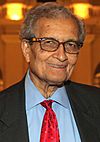 |
Amartya Sen | West Bengal | 1933- | Sen is an economist and the winner of the Nobel memorial prize in economic sciences in 1998. | |
 |
Gopinath Bordoloi# | Assam | 1890-1950 | Bordoloi was an independence activist and politician, who served as the first chief minister of Assam (1946–50). His was instrumental in uniting Assam with India when parts of it wanted to accede to Pakistan. | |
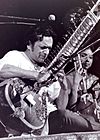 |
Ravi Shankar | Uttar Pradesh | 1920-2012 | Ravi Shankar was a musician and sitar player. He has won four Grammy Awards and is often considered "the world's best-known exponent of Hindustani classical music". | |
| 2001 | 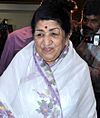 |
Lata Mangeshkar | Maharashtra | 1929-2022 | Mangeshkar was a playback singer, known as the "nightingale of India". She started her career in the 1940s and has sung songs in over 36 languages. In 1989, Mangeshkar was awarded the Dadasaheb Phalke Award, India's highest award in cinema. |
 |
Bismillah Khan | Bihar | 1916-2006 | Khan was a Hindustani classical shehnai player, who played the instrument for more than eight decades and is credited to have brought the instrument to the centre stage of Indian music. | |
| 2009 | 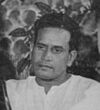 |
Bhimsen Joshi | Karnataka | 1922-2011 | Joshi was a Hindustani classical vocalist, who was a disciple of Kirana gharana and is widely known for the Khyal genre of singing. |
| 2014 | 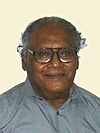 |
C. N. R. Rao | Karnataka | 1934- | Rao is a chemist and a scientist specializing in solid state chemistry. He has honorary doctorates from 86 universities and has authored around 1,800 research publications and 56 books. |
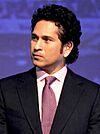 |
Sachin Tendulkar | Maharashtra | 1973- | Tendulkar is a cricketer, who is regarded as one of the greatest batters of all-time. Having debuted in 1989, Tendulkar played 664 international cricket matches, scoring more than 34,000 in a career spanning over two decades and holds various cricket records. | |
| 2015 | 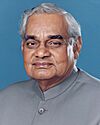 |
Atal Bihari Vajpayee | Madhya Pradesh | 1924-2018 | Vajpayee was a politician, who served as the Prime Minister of India three times in 1996, 1998 and from 1999 to 2004. He was a parliamentarian for over four decades and was elected nine times to the Lok Sabha, twice to the Rajya Sabha, also serving as the minister of external affairs during 1977–79. |
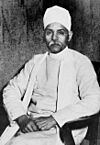 |
Madan Mohan Malaviya# | Uttar Pradesh | 1861-1946 | Malaviya was a scholar and educational reformer, who founded the Akhil Bharatiya Hindu Mahasabha (1906) and Banaras Hindu University, while serving as the university's vice-chancellor from 1919 until 1938. He was the President of Indian National Congress for four terms and was the chairman of Hindustan Times from 1924 to 1946. | |
| 2019 | 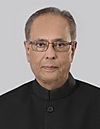 |
Pranab Mukherjee | West Bengal | 1935-2020 | Mukherjee was a politician who served as the 13th President of India from 2012 until 2017. In a career spanning five decades, Mukherjee had been a leader of the Indian National Congress and had occupied several ministerial portfolios in the Government of India. Prior to his election as President, he was finance minister from 2009 to 2012. |
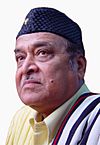 |
Bhupen Hazarika# | Assam | 1926-2011 | Hazarika was a playback singer, lyricist, musician, poet and film-maker, widely known as Sudhakantha. His songs, written and sung mainly in the Assamese language by himself, are themed around universal justice and peace and have been translated and sung in many languages. | |
 |
Nanaji Deshmukh# | Maharashtra | 1916-2010 | Deshmukh was a social activist and politician, who worked in the fields of education, health, and rural self-reliance. He was a leader of the Bharatiya Jana Sangh and also served as a member of the Rajya Sabha. | |
| 2024 |  |
Karpoori Thakur# | Bihar | 1924-1988 | Thakur was a politician, who served two terms as the 11th Chief Minister of Bihar, from 1970 to 1971, and from 1977 to 1979. In 1978, he introduced the reservation policy in state government jobs. |
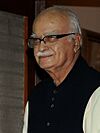 |
L. K. Advani | Delhi | 1927- | Advani is a politician who served as the 7th Deputy Prime Minister of India from 2002 to 2004. He is one of the co-founders of Bharatiya Janata Party and is credited with scripting the rise of the BJP as a major political force through the Ram Janmabhoomi Movement. He is popularly known as "Loh Purush" (Iron Man). | |
 |
P. V. Narasimha Rao# | Telangana | 1921-2004 | Narasimha Rao, was an Indian lawyer and politician who served as the 9th prime minister from 1991 to 1996. He was the first Prime Minister from South India. He is known for introducing various liberal reforms to India's economy. | |
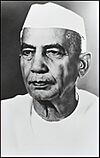 |
Chaudhary Charan Singh# | Uttar Pradesh | 1902-1987 | Charan Singh was an Indian politician and a independence activist who served as the 5th prime minister from 1979 to 1980. He is known as the "Champion of India's peasants". He is credited for bringing radical land reform measures and bringing uniformity in the farm sector. These reforms were implemented through the Debt Redemption Bill, the Land Holding Act, and the Zamindari Abolition Act. He was the founder of the political party Lokdal in 1980. | |
 |
M. S. Swaminathan# | Tamil Nadu | 1925-2023 | Swaminathan was an Indian agronomist, geneticist and administrator, who was as a global leader of the green revolution. He was one of the major architects of green revolution in India known for his leadership and role in introducing and further developing high-yielding varieties of wheat and rice. |
See also
 In Spanish: Premio Bharat Ratna para niños
In Spanish: Premio Bharat Ratna para niños
- Orders, decorations, and medals of India
- Padma Vibhushan
- Padma Bhushan
- Padma Shri


